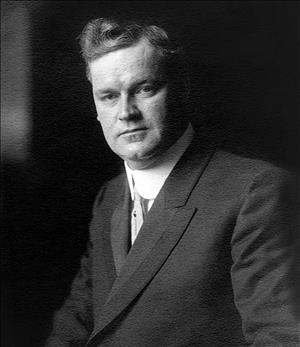On March 13, 1917, an armed intruder – trailed by Olympia's police chief and another policeman, who fail to stop him – walks into the capitol building and barges into the office of Governor Ernest Lister (1870-1919), who escapes before the man has a chance to accost him. He hides in a document vault in the state auditor's office while the trespasser is eventually talked down out of a window by the assistant chief clerk of the House of Representatives. In a hearing four day later, the man is found to be insane. The episode leads to the first efforts to provide security at the capitol.
Keystone Cops
Patrons were enjoying a quiet late lunch in a restaurant near the statehouse when a customer suddenly leapt to his feet and began shouting and gesturing wildly. Someone called the police, and Chief Harry Cusack and Sergeant Benjamin Peck soon arrived. The man flashed a long-barreled .38 caliber revolver and began walking toward the statehouse, pursued by the two officers, who followed him for at least a block but did not stop him.
The capitol was already on edge. Six weeks earlier the state insurance commissioner, E. W. Olson (1873-1917), had been shot to death at his desk by an injured logger who was angered by what he saw as the state's low valuation of his worker's compensation claim. Lister himself had received threatening mail relating to the high level of labor unrest in the state. But this had not translated into a more robust security presence at the capitol building, and in early 1917, there was none. The assailant – later identified as Charles Lorenz Wagner – had no trouble entering the statehouse and walking unimpeded to the governor's office.
Wagner confronted Lister's secretary, Irvin Ziegaus, in an outer room adjacent to the executive suite. Alerted by a clerk, Ziegaus rose from his desk as Wagner approached and asked him to wait as he strode toward Lister's office. At some point enroute from the restaurant, Wagner had put his pistol into a sack he was carrying. Now he pulled it out and pointed it at Ziegaus. He shouted, "I'm a Mason [a fraternal organization in which Lister was also a member] and I'll have this out with the governor. I'll plug the first man who tries to stop me" ("Armed Lunatic …"). By this time Cusack and the patrolman were on the scene. Cusack ordered Wagner not to enter Lister's office, but neither he nor Peck tried to stop him.
The Standoff
Lister, who was in conference with State Adjutant General Maurice Thompson, heard the disturbance. He looked out the door and saw Wagner backing toward him, gun drawn. He and Thompson raced out through the stenographer's room and into a private hallway. Lister briefly ducked into a quiet office but then sought refuge in a more secure location in a document-storage vault in the state auditor's office. Meanwhile, Cusack took up a position at the main entry to Lister's office while Peck covered the back door, where they waited for the intruder to make the next move.
Seemingly bewildered, Wagner stood alone in the suite for a few minutes, then looked out a window and down at the lawn. He was greeted by the assistant chief clerk of the House, A. W. Calder, who had volunteered to confront the trespasser. He casually struck up a conversation with Wagner and tossed a cigar up to him. Wagner noticed the army badge denoting meritorious service that Calder was wearing, and this seemed to impress him. After talking for 15 or 20 minutes, Calder asked him to come down, assuring him that no one would harm him. Someone brought a ladder. Wagner came out onto the windowsill, hesitated, went back in. After several more minutes he came back out onto the windowsill and talked to Calder a bit more. He threw down his gun and emptied his pockets. He threw down his coat to show that he was completely disarmed, then climbed down the ladder, still smoking the cigar Calder had given him.
The two men shook hands, and Calder introduced him to Thurston County Sheriff John Gifford, who escorted him to a jail cell. Wagner explained that he had not intended to harm Lister but had instead sought sanctuary in his office, as he belonged to a religious sect that planned to burn him at the stake. "They can't make no Roman holiday out of me," he declared. [But] I knew they couldn't harm me in a place like that with Washington's picture there and everything. Notice how I at once got under the American flag?" ("Armed Lunatic …"). Wagner also said that he was "crazy" and had previously been in an asylum in Wisconsin.
End of an Era
Four days later, in a perfunctory superior court hearing in Olympia, Wagner was found insane and committed to Western State Hospital in Steilacoom. Chief Cusack testified as to the defendant's incompetency in the hearing, and explained it was this very condition which had prevented him from stopping the intruder. Expounding further, Cusack said he "felt sure Wagner must be crazy" ("Governor Planning …") but that he did not believe the man intended to shoot the governor.
Lister was not so sure. After issuing a statement criticizing the Olympia police for their inaction, he ordered the Board of Control to provide guards for the state's executive offices. It was the end of an era at the state capitol.

